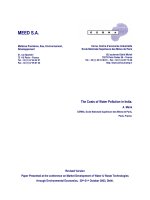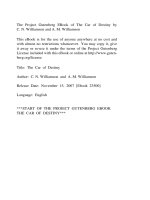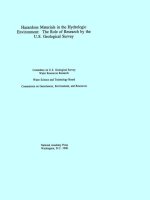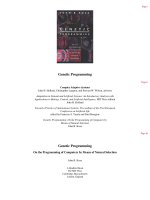The Dawn of Reason, by James Weir pot
Bạn đang xem bản rút gọn của tài liệu. Xem và tải ngay bản đầy đủ của tài liệu tại đây (1.18 MB, 573 trang )
The Project Gutenberg EBook of The Dawn of
Reason, by James Weir
This eBook is for the use of anyone
anywhere at no cost and with
almost no restrictions whatsoever. You may
copy it, give it away or
re-use it under the terms of the Project
Gutenberg License included
with this eBook or online at
www.gutenberg.org
Title: The Dawn of Reason
or, Mental Traits in the Lower Animals
Author: James Weir
Release Date: May 25, 2007 [EBook #21608]
Language: English
*** START OF THIS PROJECT GUTENBERG EBOOK
THE DAWN OF REASON ***
Produced by Marilynda Fraser-Cunliffe,
Anne Storer and the
Online Distributed Proofreading Team at
Transcriber's Notes: Inconsistencies in
hyphenation left in as per original text.
Wo r d s underlined have a mouseover
function.
THE
DAWN OF
REASON
OR
MENTAL TRAITS IN
THE
LOWER ANIMALS
BY
JAMES WEIR, JR.,
M.D.
New York
THE MACMILLAN COMPANY
LONDON: MACMILLAN & CO., Ltd.
1899
All rights reserved
Copyright, 1899,
By THE MACMILLAN COMPANY.
Norwood Press
J. S. Cushing & Co.—Berwick & Smith
Norwood Mass. U.S.A.
To My Father
WHO, WHILE NOT A SCIENTIST, HAS
YET TAKEN
AN INTELLIGENT AND
APPRECIATIVE
INTEREST IN MY WORK
THIS BOOK IS RESPECTFULLY
DEDICATED
PREFACE
Most works on mind in the lower animals
are large and ponderous volumes, replete
with technicalities, and unfit for the
general reader; therefore the author of this
book has endeavored to present the
evidences of mental action, in creatures
lower than man, in a clear, simple, and
brief form. He has avoided all
technicalities, and has used the utmost
brevity consistent with clearness and
accuracy. He also believes that
metaphysics has no place in a discussion
of psychology, and has carefully refrained
from using this once powerful weapon of
psychologists.
Many of the data used by the authors of
more pretentious works are second-hand
or hearsay; the author of this treatise,
however, has no confidence in the
accuracy of such material, therefore he has
not made use of any such data. His
material has been thoroughly sifted, and
the reader may depend upon the absolute
truth of the evidence here presented.
The author does not claim infallibility;
some of his conclusions may be
erroneous; he believes, however, that
future investigation will prove the verity
of every proposition that is advanced in
this book. These propositions have been
formulated only after a twenty-years study
of biology in all of its phases.
Some of the data used in this volume have
appeared in Appleton's Popular Science
Monthly, Lippincott's Magazine,
Worthington's Magazine, New York
Medical Record, Recreation, Atlantic
Monthly, American Naturalist, Scientific
American, Home Magazine, Popular
Science News, Denver Medical Times,
and North American Review; therefore the
author tenders his thanks to the publishers
of these magazines for their kindness in
allowing him to use their property in
getting out this work.
"Waveland," Owensboro, Ky.,
January 9, 1899.
CONTENTS
INTRODUCTION
CONSCIOUS AND UNCONSCIOUS
MIND
PAGE
Definition of mind—The correlation of
physiology, morphology, and
psychology—The presence of nerve-
elements in monera—Conscious and
unconscious mind—Unconscious
("vegetative") mind in the jelly-fish
—Anatomy, physiology, and
psychology of the jelly-fish—The
origin of conscious mind.
CHAPTER I
THE SENSES IN THE LOWER
ANIMALS
The sense of touch—The senses of taste
and smell—Actinophryans having
taste—The sense of sight—
Modification of sight organs by
surroundings—Sight in
Actinophryans—Blind fish sensitive
to light—Blind spiders—Blind man
—Primitive eyes in Cymothoe—In
the jelly-fish, sea-urchin, Alciope,
Myrianida—The sight organs of the
snail—Power of vision in the snail—
Eyes of crayfish—Compound eyes—
Vision in "whirligig beetle"—In
Periophthalmus—In Onchidium—In
Calotis—Organs of audition—In
Lepidoptera—Hymenoptera—Orthoptera
marginalis—Corydalus—Ears of
grasshopper and cricket—Of the
"red-legged locust"—Of flies—Of
gnats—Auditory vesicles of horse-fly
—Ears of butterflies—Cerambyx
beetle—Long-horned beetle
—Cicindelidæ—Carabidæ.
CHAPTER II
CONSCIOUS DETERMINATION
Definition—How conscious
determination is evolved from the
senses—The presence of nerve-
tissue in Stentor polymorphus—The
properties of nerve-tissue—
Romanes' experiment with anemone
—Action of stimuli on nerve-tissue
—Reflection—Origin of
consciousness—Time element in
consciousness—Conscious
determination in Stentor
polymorphus— I n Actinophrys—In
Amœba— I n Medusa—In a water-
louse—In a garden snail—In the
angle-worm—In oysters—In a
ground wasp.
CHAPTER III
MEMORY
Discussed under four heads, viz.
Memory of Locality (Surroundings),
Memory of Friends (Kin) , Memory
of Strangers (Other animals not
kin), and Memory of Events
(Education, Happenings, etc.)—
Memory of locality in Actinophrys—
In the snail—In the ant—In sand
wasps—In beetles—In reptiles
—Memory of Friends—In ants—
Experiments with ants, Lasius flavus,
Lasius niger, and Myrmica
ruginodis—Memory of kin in wasps
and bees—Experiments—Memory of
Strangers (Animals other than kin)
—Recognition of enemies—By
bumblebees—Memory of individuals
not enemies—By the toad—By the
spider—By ants—By snakes—By
chameleons—By birds—By cattle—
By dogs—By monkeys—Memory of
Events (Education, etc.)—In the
wasp—In fleas—In the toad—In
other insects.
CHAPTER IV
THE EMOTIONS
The higher animals—Laughter—In
monkeys—In the dog—In the
chimpanzee—In the orang-utan—
Fear, dismay, consternation, grief,
fortitude, joy shown by bees—
Affection for the individual evinced
by house wren—Anger, hate, fear,
revenge, in the higher animals—
Forgiving disposition in the monkey
—Sympathy—In ants—Care of young
by ants—Solicitude of butterflies—
Of gadfly—Of the ichneumon fly—Of
the mason wasp—Of the spider—Of
the earwig—Anger and hate evinced
by ants, centipedes, tarantulas,
weevils.
CHAPTER V
ÆSTHETICISM
The love of music—In spiders—In
quail—In dogs—Origin of love of
music in the dog—Dog's knowledge
of the echo—Love of music in rats—
In mice—Singing mice—Love of
music in lizards—In salamanders—
In snakes—In pigeons—In the
barnyard cock—In the horse—
Amusement and pastime—In
Actinophrys—In the snail—In
Diptera—In ants—In lady-bugs
(Coccinellæ)—Æsthetic taste in
birds—The snakeskin bird—
Humming-bird—Bower bird—The
love of personal cleanliness—In
birds—In insects—In the locust.
CHAPTER VI
PARENTAL AFFECTION
Origin of parental feeling—Evidence of
this psychical trait in spiders—In
earwigs—In crayfish—In butterflies
—In fish—In toads—In snakes—
Instance of pride in parents—In the
dog—In the cat—Parental affection
in birds—Animals seeking the
assistance of man when their
offspring is in danger—The evolution
of parental affection.









